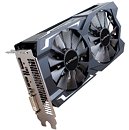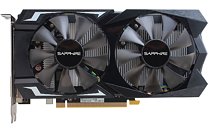- Joined
- Oct 9, 2007
- Messages
- 47,636 (7.44/day)
- Location
- Dublin, Ireland
| System Name | RBMK-1000 |
|---|---|
| Processor | AMD Ryzen 7 5700G |
| Motherboard | Gigabyte B550 AORUS Elite V2 |
| Cooling | DeepCool Gammax L240 V2 |
| Memory | 2x 16GB DDR4-3200 |
| Video Card(s) | Galax RTX 4070 Ti EX |
| Storage | Samsung 990 1TB |
| Display(s) | BenQ 1440p 60 Hz 27-inch |
| Case | Corsair Carbide 100R |
| Audio Device(s) | ASUS SupremeFX S1220A |
| Power Supply | Cooler Master MWE Gold 650W |
| Mouse | ASUS ROG Strix Impact |
| Keyboard | Gamdias Hermes E2 |
| Software | Windows 11 Pro |
Sapphire today rolled out its Pulse Radeon RX 560 LITE series graphics cards, which implement the 896 stream-processor variant of the "Polaris 21" silicon, as opposed to the better endowed 1,024 SP version the RX 560 SKU originally launched with. The card is available in 2 GB and 4 GB variants, and comes slightly factory-overclocked, with its GPU engine clock bumped to 1300 MHz, while the memory is clocked at 7.00 GHz (GDDR5-effective). The card itself features a slightly more beefed-up product design as opposed to the original Pulse RX 560.
While the original Pulse RX 560-series cards feature a simple copper core aluminium fan-heatsink cooler, in which a single chunk of aluminium with radially (well, spirally) projecting fins, ventilated by a single fan keeps the GPU cool; the new Pulse RX 560 LITE series features a slightly larger, rectangular aluminium heatsink, ventilated by two fans; with a separate heatsink over the VRM. The card draws power from a single 6-pin PCIe power connector. Expect the card to be priced around the $100-mark (MSRP, not marked up to kingdom come by retailers).




View at TechPowerUp Main Site
While the original Pulse RX 560-series cards feature a simple copper core aluminium fan-heatsink cooler, in which a single chunk of aluminium with radially (well, spirally) projecting fins, ventilated by a single fan keeps the GPU cool; the new Pulse RX 560 LITE series features a slightly larger, rectangular aluminium heatsink, ventilated by two fans; with a separate heatsink over the VRM. The card draws power from a single 6-pin PCIe power connector. Expect the card to be priced around the $100-mark (MSRP, not marked up to kingdom come by retailers).




View at TechPowerUp Main Site






